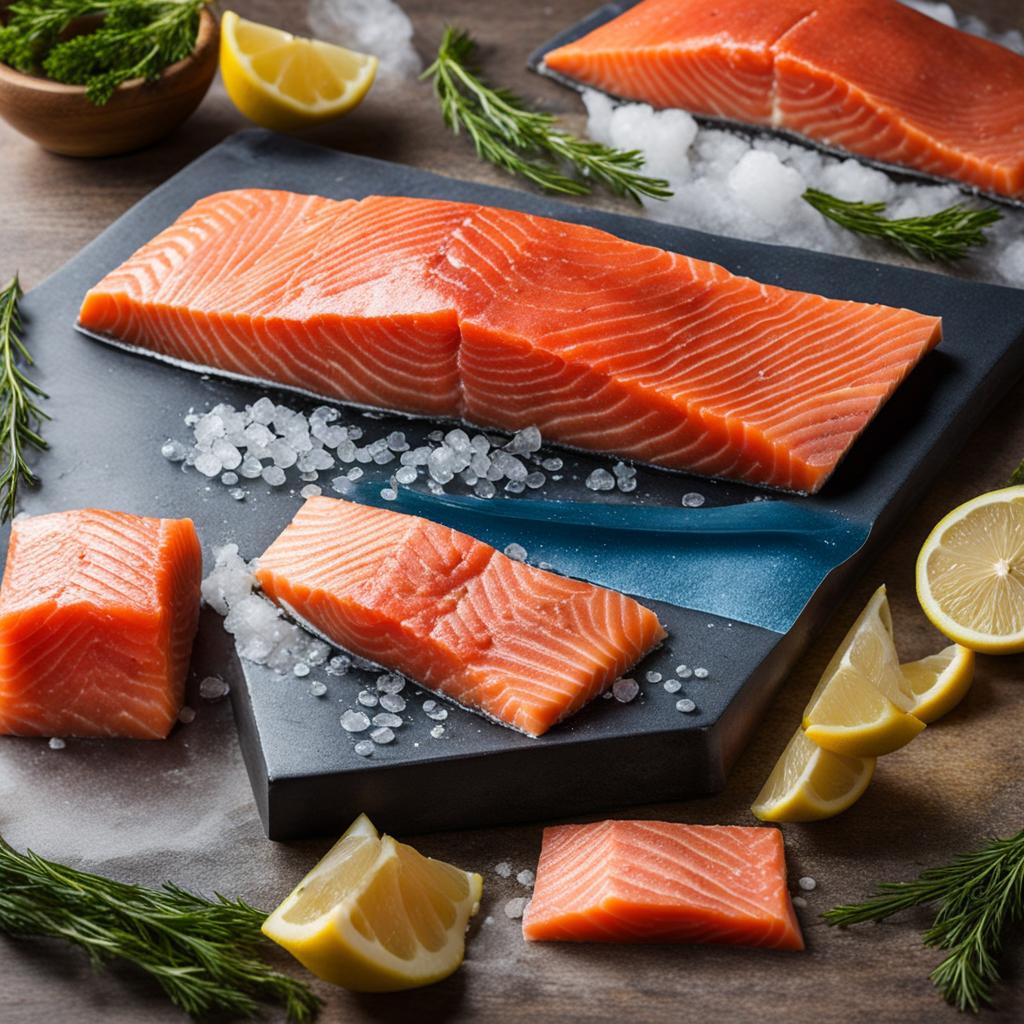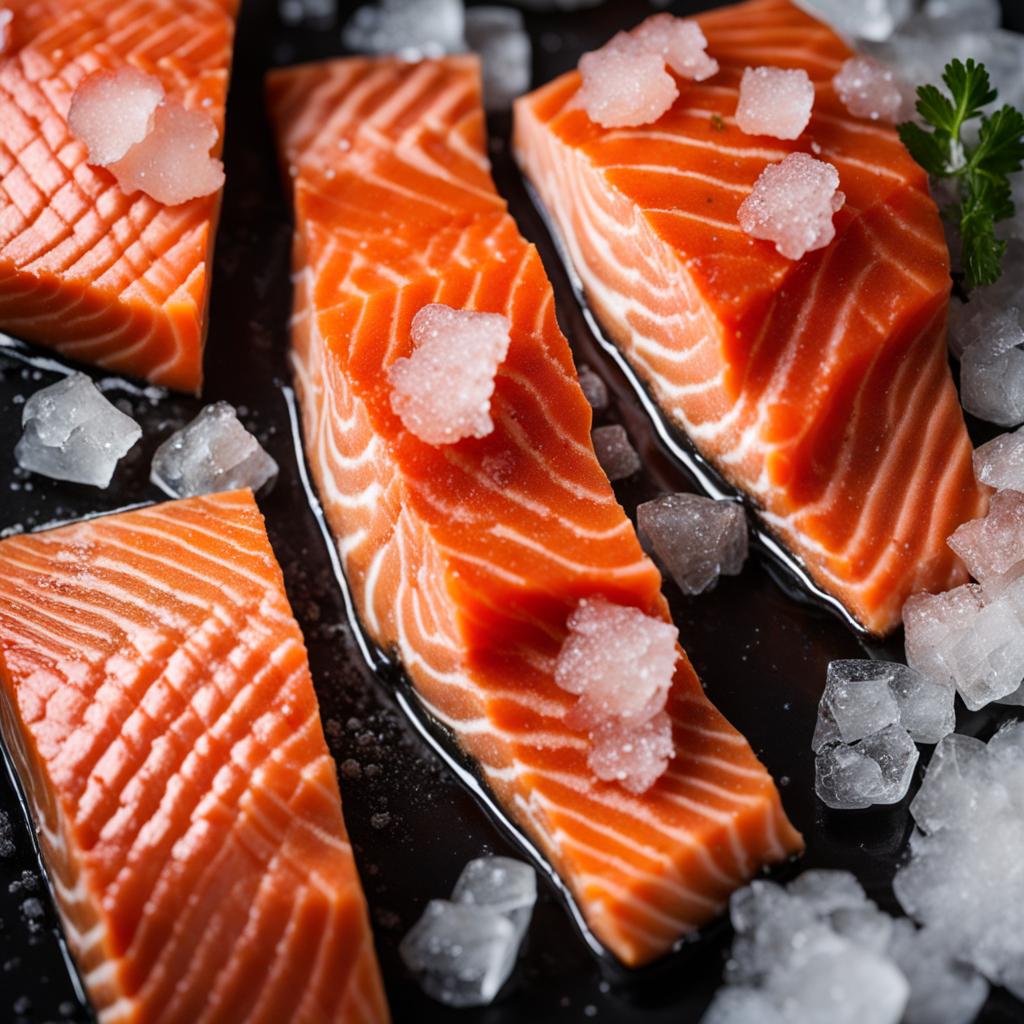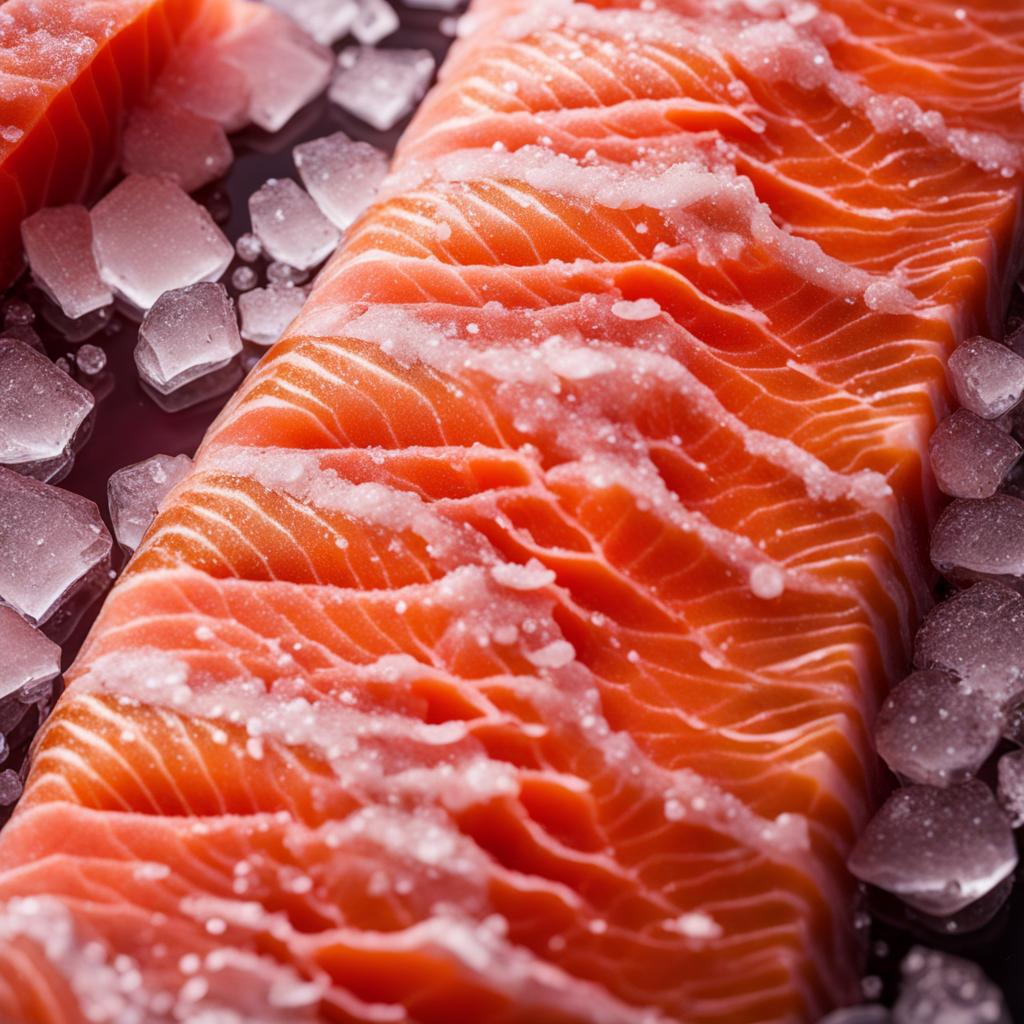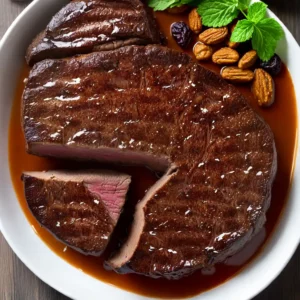Salmon is not only a delicious seafood option, but it’s also packed with nutrients that are essential for a healthy diet. Whether you’ve caught it yourself or bought it fresh from the market, knowing how to properly freeze salmon is key to retaining its freshness and flavor. In this guide, I will share some valuable tips and techniques to help you freeze salmon effectively and ensure it stays in top condition until you’re ready to cook it.
Key Takeaways:
- Freezing salmon is an effective way to extend its shelf life and retain its freshness.
- When buying fresh salmon, look for vibrant color, firm texture, clear eyes, shiny skin, and a fresh smell.
- Store fresh salmon in the refrigerator, wrapped in butcher paper, plastic wrap, or an airtight glass container.
- To freeze salmon, tightly wrap it in plastic wrap, place it in a resealable freezer bag, and remove as much air as possible.
- Thaw frozen salmon safely by placing it in the refrigerator overnight or submerging it in room temperature water.
Buying Fresh Salmon: Tips for Choosing the Best
When it comes to buying fresh salmon, there are a few key tips to keep in mind to ensure you choose the best quality fish for your meals. By paying attention to certain characteristics, you can be confident that you are selecting a fresh and flavorful piece of salmon.
Visual Cues for Freshness
Visual cues play an important role in determining the freshness of salmon. Look for fillets or whole fish with vibrant color, indicating that it is still at its peak freshness. The flesh should appear firm and have a glossy texture. Avoid salmon with any discoloration, dullness, or dry patches, as these can be signs of age or poor quality.
Other Indicators of Quality
In addition to visual cues, there are other signs that indicate the freshness and quality of salmon. Check the eyes of the fish – they should be clear, not cloudy or sunken. The skin should be shiny and intact, without any blemishes or signs of damage. When you smell the salmon, it should have a fresh, marine scent, free from any strong or unpleasant odors.
Trust Your Senses
Ultimately, when buying fresh salmon, trust your senses. Use your eyes, nose, and even touch to evaluate the quality of the fish. By paying attention to these visual and sensory cues, you can ensure that you are bringing home the best possible salmon for your next delicious meal.
| Visual Cues | Other Indicators of Quality | Trust Your Senses |
|---|---|---|
| Vibrant color | Clear eyes | Use your senses |
| Glossy texture | Shiny skin | Trust your instincts |
| No discoloration | Fresh smell | |
Storing Fresh Salmon: Keeping it Cold
Proper storage of fresh salmon is crucial in maintaining its quality and freshness. To ensure the fish stays cold and safe to eat, follow these tips:
- After purchasing fresh salmon, immediately store it in the refrigerator to prevent bacterial growth. The ideal temperature for refrigerating salmon is between 32°F and 38°F.
- Before storing, wrap the salmon tightly in butcher paper or plastic wrap to protect it from air and moisture. Alternatively, place it in an airtight glass container.
- Label the packaged salmon with the date of storage to keep track of its freshness.
- When storing in the refrigerator, use the salmon within a day or two to enjoy it at its best quality.
By keeping fresh salmon cold and properly stored, you can retain its optimal texture, flavor, and nutritional value for a longer period.
“Proper storage is essential in maintaining the freshness and quality of fresh salmon.”
Now that we’ve covered the basics of storing fresh salmon, let’s move on to the proper techniques for freezing salmon in the next section.
Freezing Salmon: Proper Techniques
When it comes to freezing salmon, using the proper techniques is essential to maintain its quality and freshness. By following these steps, you can ensure that your frozen salmon will taste just as delicious as when you first bought it.
Step 1: Tightly wrap the salmon
Start by tightly wrapping the salmon in plastic wrap. This will help prevent air from reaching the fish and causing freezer burn. Make sure the entire salmon fillet is covered and seal it as tightly as possible.
Step 2: Place in a resealable freezer bag
After wrapping the salmon, place it in a resealable freezer bag. This will provide an extra layer of protection against freezer burn and help keep the fish fresh. Be sure to remove as much air as possible from the bag before sealing it.
Step 3: Label with the date
To keep track of how long the salmon has been in the freezer, label the bag with the date. This way, you can easily determine its storage time and ensure that you use it within the recommended timeframe.
| Step | Technique |
|---|---|
| 1 | Tightly wrap salmon in plastic wrap |
| 2 | Place wrapped salmon in a resealable freezer bag |
| 3 | Label the bag with the date |
By following these freezing techniques, you can ensure that your salmon retains its taste, texture, and nutritional value when thawed and cooked. Properly frozen salmon can last up to three months in the freezer, allowing you to enjoy this delicious fish at any time.

Thawing Frozen Salmon: Safe Methods
Thawing frozen salmon properly is essential to ensure its quality and safety before cooking. There are two safe methods that you can use to thaw frozen salmon and prepare it for a delicious meal.
1. Refrigerator Thawing
Recommended for: Frozen salmon when you have enough time for slow thawing.
To thaw frozen salmon in the refrigerator:
- Place the packaged salmon on a plate or in a shallow dish to catch any juices.
- Place the plate or dish on the bottom shelf of the refrigerator.
- Allow the salmon to thaw slowly in the refrigerator overnight or for approximately 8-12 hours.
Refrigerator thawing ensures a gradual thaw, minimizing the risk of bacterial growth and keeping the salmon at a safe temperature throughout the process.
2. Cold Water Thawing
Recommended for: Frozen salmon when you need to thaw it quickly.
To thaw frozen salmon using the cold water method:
- Ensure the salmon is tightly sealed in a leak-proof plastic bag to prevent water from entering.
- Fill a large bowl or sink with cold water.
- Submerge the sealed salmon in the cold water, making sure it is fully immersed.
- Change the water every 30 minutes to maintain a cold temperature.
- Thaw the salmon until it is flexible and no longer frozen, usually within 1-2 hours depending on the thickness of the salmon.
Using the cold water method allows for quicker thawing while still ensuring the salmon remains at a safe temperature.
Remember, once the salmon has thawed, it should be cooked immediately and not refrozen. Thawed salmon can be cooked using various methods such as baking, grilling, or pan-searing to create a delicious and healthy meal.
Cooking Frozen Salmon: Not Recommended
When it comes to cooking frozen salmon, it is not recommended. Thawing the salmon before cooking is essential for even cooking and to prevent the growth of harmful bacteria. While it may be tempting to skip the thawing process for convenience, it can result in an unevenly cooked fish and potential health risks. To ensure the best taste and texture of your salmon, it is important to follow proper thawing methods.
Thawing frozen salmon allows it to cook more evenly, ensuring that the center is fully cooked without the outer layers becoming overcooked. Thawing also helps retain the moisture and flavor of the fish, resulting in a more delicious meal. By taking the time to thaw the salmon properly, you can enjoy the full potential of its natural flavors and textures.
“Thawing frozen salmon allows for even cooking and better flavor preservation. It’s a step that should not be skipped to ensure a quality dining experience.” – Seafood Expert
There are various safe thawing methods you can use for frozen salmon. One method is to place the frozen salmon in the refrigerator overnight, allowing it to thaw slowly and safely. Another option is to submerge the frozen salmon in a zipper-lock bag in room temperature water. This method can help speed up the thawing process, but it is important to ensure that the salmon is fully thawed before cooking.
By following these recommended thawing methods and avoiding cooking frozen salmon, you can enjoy a perfectly cooked and delicious meal that highlights the natural flavors of this nutritious fish.

Table: Pros and Cons of Cooking Frozen Salmon
| Pros | Cons | |
|---|---|---|
| Pros |
|
|
Safe Storage Duration: Fresh and Cooked Salmon
Proper storage of fresh and cooked salmon is essential to maintain its quality and ensure its safety for consumption. Whether you have just bought fresh salmon or have leftovers from a delicious meal, knowing the safe storage duration is important.
Safe Storage Duration for Fresh Salmon
When it comes to storing fresh salmon, it is best to use it within a couple of days to preserve its freshness and flavor. Fresh salmon can be stored in the refrigerator for up to two days in a tightly wrapped package or an airtight glass container.

Safe Storage Duration for Cooked Salmon
For leftovers or cooked salmon, proper storage is crucial to maintain its taste and quality. Cooked salmon can be stored in an airtight container in the refrigerator for up to three days. It is important to cool the cooked salmon quickly before storing it to prevent the growth of bacteria.
For longer storage, cooked salmon can be frozen for up to three months. Ensure that the cooked salmon is completely cooled before transferring it to a freezer-safe container or a resealable freezer bag. Label the container or bag with the date to keep track of its storage time.
Summary
- Fresh salmon can be stored in the refrigerator for up to two days.
- Cooked salmon can be kept in an airtight container in the refrigerator for three days.
- Cooked salmon can be frozen for up to three months.
By following these guidelines, you can enjoy fresh and flavorful salmon while ensuring its safety and quality.
Freezing Smoked Salmon Slices
Smoked salmon is a flavorful delicacy that can be a wonderful addition to your meals. But what if you have more smoked salmon slices than you can consume? Freezing them is a great way to preserve their taste and texture for an extended period. Here are some simple steps to freeze smoked salmon slices:
- Start by wrapping each smoked salmon slice tightly in plastic wrap. This will help protect the slices from freezer burn and maintain their freshness.
- Place the wrapped slices in a resealable zipper-lock bag. Make sure to remove as much air as possible from the bag before sealing it. This will help prevent any freezer-induced moisture from affecting the salmon.
- Label the bag with the current date. This will make it easier for you to keep track of the storage time and ensure that you use the salmon within the recommended timeframe.
- Store the bag of smoked salmon slices in the freezer. Smoked salmon can be frozen for up to two months without compromising its flavor and texture.
When you’re ready to use the frozen smoked salmon slices, simply thaw them in the refrigerator overnight or use the quick thawing method mentioned earlier in this article. Once thawed, the slices can be enjoyed in various dishes, such as salads, sandwiches, or as a topping for bagels.
Table: Freezing Smoked Salmon Slices
| Step | Description |
|---|---|
| 1 | Wrap each smoked salmon slice tightly in plastic wrap. |
| 2 | Place the wrapped slices in a resealable zipper-lock bag, removing as much air as possible. |
| 3 | Label the bag with the date. |
| 4 | Store the bag in the freezer for up to two months. |
Freezing smoked salmon slices is a convenient way to make the most of this delectable treat. By following these simple steps, you can ensure that your smoked salmon remains delicious and ready to elevate any dish whenever you desire.
Proper Sous Vide Cooking: Removing Cling Wrap
When it comes to cooking salmon using the sous vide method, it’s important to follow the proper techniques for a safe and delicious meal. One crucial step is to remove the cling wrap before cooking. While cling wrap is commonly used for storing salmon, it is not suitable for cooking in a sous vide due to its potential to melt and contaminate the food.
“Using cling wrap in a sous vide can result in a messy and potentially hazardous situation,” says Chef Smith. “Plastic wrap is not designed to withstand the high temperatures involved in sous vide cooking.”
To ensure safe and effective cooking, it is recommended to transfer the salmon from the plastic wrap to a vacuum-sealed bag. Vacuum-sealed bags are specially designed to withstand the sous vide cooking process and maintain the integrity of the fish. By removing the cling wrap and using a suitable alternative, you can enjoy perfectly cooked salmon with all its flavors and nutrients preserved.
Remember, proper sous vide cooking involves paying attention to every detail, including the materials used. By following these guidelines and removing the cling wrap, you can confidently prepare a delicious sous vide salmon dish that will impress your guests and elevate your culinary skills.

| Sous Vide Method | Advantages | Disadvantages |
|---|---|---|
| Vacuum-Sealed Bag | – Maintains moisture and flavor – Ensures even cooking |
– Requires vacuum sealer equipment – More expensive |
| Cling Wrap | – Easily accessible – Convenient for storage |
– Melts at high temperatures – Contaminates food |
| Ziplock Bag | – Budget-friendly option – Widely available |
– Prone to leaks – May affect flavor and texture |
Choosing the right method for sous vide cooking is essential for achieving the best results. While cling wrap may be convenient for storing salmon, it is not suitable for the cooking process. By removing the cling wrap and opting for vacuum-sealed bags, you can ensure a safe and successful sous vide cooking experience.
Proper Handling of Cooked Salmon: Shelf Life
When it comes to cooked salmon, proper handling is crucial to maintain its taste and quality. To ensure you make the most of your cooked salmon, it’s important to understand its shelf life and the best way to store it.
When stored in an airtight container in the refrigerator, cooked salmon can remain fresh for up to three days. This allows you to enjoy leftovers or plan your meals in advance. However, if you need to store it for longer, freezing is the way to go.
By freezing cooked salmon in an airtight container or freezer bag, you can extend its shelf life for up to three months. This is particularly useful if you have extra portions or want to plan meals ahead of time. Freezing preserves the taste and quality of the salmon, allowing you to enjoy it at your convenience.
Table: Shelf Life of Cooked Salmon
| Storage Method | Shelf Life |
|---|---|
| Refrigerator (airtight container) | Up to three days |
| Freezer (airtight container or freezer bag) | Up to three months |
Remember to label your containers or freezer bags with the date of freezing to keep track of the storage time. When you’re ready to enjoy your frozen cooked salmon, simply thaw it in the refrigerator overnight before reheating or incorporating it into your favorite recipes.
Proper handling and storage of cooked salmon ensure that you can enjoy this delicious and nutritious fish for an extended period. Whether you choose to refrigerate it for a few days or freeze it for longer storage, cooked salmon can be a convenient and versatile addition to your meals.
Storage Duration for Frozen Fish in Freezer
When it comes to freezing fish, including salmon, proper storage duration is essential to maintain quality and taste. Freezing can prolong the shelf life of fish, allowing you to enjoy its freshness even months later. However, it’s important to note that the quality of the frozen fish may gradually deteriorate over time. To ensure the best flavor and texture, it is recommended to use frozen fish within six months.
Here is a breakdown of the storage duration for frozen fish, including salmon:
- Frozen Fish: Up to a year – Fish, including salmon, can last up to a year in the freezer, especially when the freezer is rarely opened. This prolonged duration ensures the fish remains safe to consume, but it’s worth noting that the quality may start to decline after six months.
- Frozen Cooked Salmon: Up to three months – If you have cooked salmon that you want to freeze, it can be stored in the freezer for up to three months. Freezing cooked salmon helps retain its taste and quality, making it a convenient option for meal planning or leftovers.
- Frozen Smoked Salmon Slices: Up to two months – Smoked salmon slices can also be frozen for up to two months. Properly wrapping them tightly and labeling with the date ensures that the smoky flavor and texture are preserved.
Remember, freezing fish is a great way to extend its shelf life, but it’s important to keep track of the storage duration and use the fish within the recommended timeframes for the best culinary experience.
Quick Ways to Thaw Frozen Salmon
If you find yourself in need of thawing frozen salmon quickly, there are a few efficient methods you can try. By using these quick thawing techniques, you can have your frozen salmon ready to cook in no time.
The Water Submersion Method
An effective way to thaw frozen salmon is by using the water submersion method. Start by placing the frozen salmon in a resealable plastic bag, ensuring it is tightly sealed. Then, fill a large bowl or basin with room temperature water and submerge the bag in the water, making sure it is fully covered. Allow the salmon to sit in the water, periodically checking and replacing the water if it becomes too cold. Within 30-45 minutes, the salmon should be fully thawed and ready for cooking.
The Cold Water Method
If you’re short on time and need to thaw your frozen salmon even faster, you can use the cold water method. Similar to the water submersion method, place the frozen salmon in a sealed plastic bag. Then, fill a basin or sink with cold water and submerge the bag, ensuring it is fully immersed. Cold water promotes a faster thawing process than room temperature water. However, it’s essential to change the water every 30 minutes to maintain the appropriate temperature. With this method, your salmon should be fully thawed within 20-30 minutes.
Thawing in the Refrigerator
If you have more time to spare, thawing frozen salmon in the refrigerator is a safe and gradual method. Simply transfer the sealed bag of frozen salmon from the freezer to the refrigerator and let it thaw overnight. The slow thawing process in a controlled temperature environment ensures the salmon thaws evenly and retains its moisture. After thawing, be sure to use the salmon within two days for the best quality and taste.
Remember, when thawing frozen salmon, it is essential to prioritize food safety and avoid leaving the fish at room temperature for extended periods. With these quick thawing methods, you can conveniently and safely thaw your frozen salmon to enjoy a delicious meal.
Delicious Salmon Recipes: Dinner Ideas
Salmon is not only a nutritious fish but also a versatile ingredient that can be used in a variety of delicious dinner recipes. Whether you prefer a classic preparation or want to experiment with new flavors, there is a salmon recipe to suit every taste. Here are a few mouthwatering dishes to try:
Pan-Seared Salmon
This simple yet elegant recipe is perfect for a quick and flavorful dinner. Start by seasoning a fresh salmon fillet with salt and pepper. Heat some olive oil in a skillet over medium-high heat, then add the salmon skin-side down. Cook for about 4-5 minutes on each side until the skin is crispy and the salmon is cooked through. Serve with a side of steamed vegetables or a fresh salad for a wholesome meal.
Balsamic Glazed Salmon
This recipe combines the sweetness of balsamic vinegar with the rich flavors of salmon for a delightful combination. In a small saucepan, simmer balsamic vinegar until it reduces and thickens. Brush the glaze onto a salmon fillet and bake in the oven at 400°F (200°C) for about 12-15 minutes or until the salmon is cooked to your liking. The result is a tangy and succulent dish that pairs well with roasted potatoes or a bed of quinoa.
Miso-Glazed Salmon
The umami-rich flavors of miso add depth and complexity to salmon in this Japanese-inspired recipe. To make the glaze, whisk together miso paste, soy sauce, honey, and a hint of ginger. Spread the glaze over the salmon and broil it for about 6-8 minutes until the top is caramelized and the fish is cooked. Serve the miso-glazed salmon with a side of steamed rice and sautéed greens for a complete and satisfying meal.
These are just a few examples of the many delicious salmon recipes you can explore. Whether you prefer simple preparations or more elaborate dishes, salmon is a versatile fish that can be adapted to various cuisines and flavors. Get creative in the kitchen and discover your own favorite way to enjoy this nutritious and delectable fish.
Conclusion
In conclusion, freezing salmon is a great way to extend its shelf life while retaining its freshness. By following the proper techniques for buying fresh salmon, storing it at the right temperature, and properly freezing and thawing it, you can ensure that your salmon remains delicious and safe to eat.
When buying fresh salmon, remember to look for vibrant color, firm texture, clear eyes, and a fresh smell. Keep it cold in the refrigerator, and if you’re not going to use it right away, freezing it is the best option. Properly wrap the salmon in plastic wrap and freezer bags, and label them with the date for easy tracking.
Thawing frozen salmon safely is important to prevent the growth of harmful bacteria. You can thaw it in the refrigerator overnight or submerge it in room temperature water for quicker thawing. Avoid cooking salmon that is still frozen, as it may not cook evenly.
By following these freezing salmon tips and prioritizing freshness and safety throughout the process, you can enjoy a delicious and nutritious meal with the convenience of frozen salmon. So go ahead and give it a try!
FAQ
How do I choose the best fresh salmon?
Look for fillets or whole fish with vibrant color, glossy and firm texture, clear eyes, shiny skin, and a fresh smell. Avoid fish with a fishy odor or signs of spoilage.
How should I store fresh salmon?
Store fresh salmon in the refrigerator wrapped in butcher paper, plastic wrap, or an airtight glass container. Use it within a day or two for best quality.
Can I freeze salmon?
Yes, you can freeze salmon. Tightly wrap it in plastic wrap and place it in a resealable freezer bag, removing as much air as possible. Label the bag with the date and freeze for up to three months.
How should I thaw frozen salmon?
Thaw frozen salmon safely by placing it in the refrigerator overnight. For quicker thawing, submerge the salmon in a zipper-lock bag in room temperature water. Avoid transferring thawed salmon back to the refrigerator for storage.
Can I cook salmon that is still frozen?
No, it is not recommended to cook salmon that is still frozen. Thaw it using one of the safe methods mentioned above before cooking.
How long can I store fresh and cooked salmon?
Fresh salmon can be stored in the refrigerator for up to two days. Cooked salmon can be kept in an airtight container in the refrigerator for three days and in the freezer for up to three months.
Can I freeze smoked salmon slices?
Yes, you can freeze smoked salmon slices. Wrap them tightly in a resealable zipper-lock bag and label with the date. Smoked salmon can be frozen for up to two months.
Is plastic wrap suitable for sous vide cooking?
No, plastic wrap is not suitable for cooking in a sous vide. If the salmon is wrapped in plastic wrap for storage, remove it and transfer the salmon to a vacuum-sealed bag for sous vide cooking.
How long can I store cooked salmon?
Cooked salmon can be stored in an airtight container in the refrigerator for up to three days. For longer storage, freeze the cooked salmon for up to three months.
How long can frozen fish, including salmon, last in the freezer?
Fish, including salmon, can last up to a year in the freezer, especially when the freezer is rarely opened. However, for the best flavor, it is recommended to use frozen fish, including salmon, within six months.
What are quick ways to thaw frozen salmon?
To thaw frozen salmon quickly, place it in a plastic resealable bag and submerge it in room temperature water. Let it sit until fully thawed. For longer thawing time, thaw the salmon overnight in the refrigerator.
What are some delicious salmon dinner recipes?
Try recipes like Pan-Seared Salmon, Balsamic Glazed Salmon, Miso-Glazed Salmon, Lemon Butter Salmon, or Pesto Salmon Pasta for a range of flavors and cooking styles.
Source Links
- https://zestfulkitchen.com/how-to-store-salmon/
- https://www.freshseafood.com/blogs/fresh-blog/wild-about-salmon-how-to-store-fresh-salmon
- https://www.wikihow.com/Freeze-Raw-Salmon
Related Recipes:
 How to Properly Store Salmon
How to Properly Store Salmon
 How to Store Fish to Ensure Freshness
How to Store Fish to Ensure Freshness
 How to Tell if Salmon Has Gone Bad: Quality Indicators
How to Tell if Salmon Has Gone Bad: Quality Indicators
 How to Tell if Salmon is Done: Cooking Tips
How to Tell if Salmon is Done: Cooking Tips
 How to Reheat Salmon Without Overcooking
How to Reheat Salmon Without Overcooking
 How to Tell if Fish is Bad: Freshness Checklist
How to Tell if Fish is Bad: Freshness Checklist
 How to Freeze Pork: Tips for Maintaining Flavor
How to Freeze Pork: Tips for Maintaining Flavor
 Can You Freeze Garlic? Here’s How to Do It Right.
Can You Freeze Garlic? Here’s How to Do It Right.







